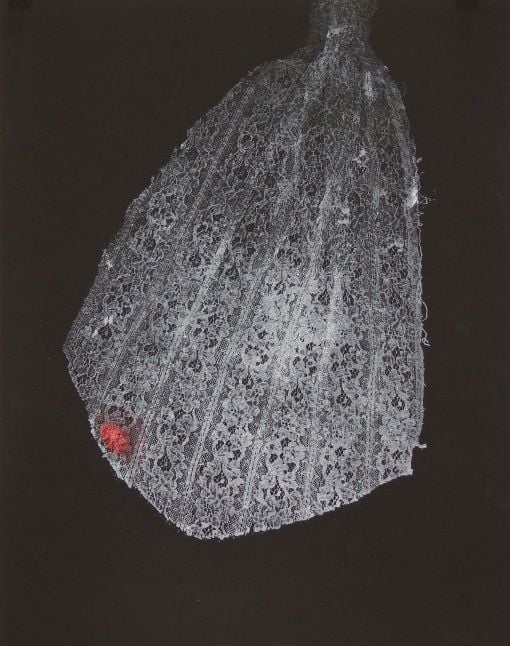Bunny Burson, The Politics of Power, BAG Gallery, 168 7th Street, Brooklyn, New York 11215, tel. (718) 858-6069. Opening Reception: Saturday, December 1, 2007, 6-9 pm.
Bunny Burson, who was raised in Tennessee, but today lives in St Louis, is passionate about politics. “I believe it’s essential to our society and to our lives. Voting is important. When people don’t vote, and when votes aren’t cast, it can have terrible consequences for all of us.”
Burson says she was always interested in politics; she grew up with it. But her real coming of age occurred in the turbulent year of 1968. “I was an exchange student that year, in France. Things didn’t go quite the way I imagined. They exploded, and I was in the middle of it.” She described the experience as an “awakening.”
“I was politically active from that point. I never stopped.” But Burson pursued a career in the graphic arts, completing an undergraduate degree at Tulane University and then an M.F.A. at Washington University in St. Louis.
Still, one election was a personal and a national trauma, says Burson. “It was 2000. I was deeply involved in the campaign and during the recount, given everything that had happened plus the added friendship with the Gores, I felt as if I were in the center of the storm.”
Most of her series in fact revolves around the events of the the 2000 election and the ultimate Supreme Court decision in Bush v. Gore that halted the recount and put George W. Bush in the Oval Office, rather than the candidate favored by Burson, fellow Tennessean Al Gore, who drew a half million more votes than his opponent.

In “Stain 2” the outcome of the election is laid at the doorstep of the Supreme Court, and particularly Justice Sandra Day O’Connor. Burson recounts that she attended a presentation by O’Connor at Washington University recently at which a questioner asked the retired justice whether she had ever made a decision she regretted? She responded with a “no.” The questioner pressed: “Not even Bush v. Gore?” And Justice O’Connor said that it was important always to look forward and never to look back.
“That irritated me,” Burson said. “Actions have consequences, and people need to take responsibility for what they’ve done. The Supreme Court’s decision in Bush v. Gore undercut our democracy. And that led me to produce ‘Stain 1 and 2,’ I took the graceful lace ascots of the sort for which Sandra Day O’Connor was famous, and treated them with a red stain for O’Connor’s partisan vote in the case. I also put bits of chad in the lace as a touch of humor and to provide some historical context.”

“537” refers to the margin of victory that George W. Bush achieved in Florida as a result of the decision to stop counting the votes. But the work points to the consequences that flowed from that action as well, the disastrous invasion and occupation of Iraq. “My artistic intent is to show the consequences of the flawed election in Florida by mocking the Iraqi vote with the blood (the red dye was taken from my own blood) being shed in its name.” When Iraqis voted to adopt their constitution, the index finger of each Iraqi who voted was tinged with a purple dye to reflect the fact that a vote had been cast. “I metaphorically applied this same process to the vote in Florida, using both red and blue dye to mark the voter preferences. It was a reminder that the voters who picked Bush were putting us on the path to a war against Iraq. The origins of the tragedy in Iraq were in the precincts of Florida, and in the suspended vote counting process.” Burson says that once word got around about her project she had lots of volunteers. “People were eager to have their index finger cast for inclusion in the piece.”

“For ‘Turbulence 2000,’ I imagined the recount as a storm overwhelming Florida and the nation. I used hurricanes, tornados and tsunamis as my metaphors in a series of large monoprints on handmade paper. I created the storms from 2000 election chad. To inject a touch of humor into these dark events I imbedded images of the cast of characters in my work. Being tossed about in the storms are Katherine Harris, Jeb Bush, Al Gore, Karl Rove, Justices O’Connor and Scalia, John Bolton and James Baker.”

The actual materials used in the voting process figure regularly in the works in Burson’s exhibition. One work in particular turns to the actual ballots as its basis.
“For ‘Powerful Consequences 2,’ I created a series of unique objects depicting ballots. Between pieces
of plexi cut to the size of a ballot, there are layers of prints and
digital imagery, which include an actual punch card ballot and maps of
Florida and Iraq. There are butterflies, caricatures of the
personalities involved, and chad collaged between them to emphasize the
powerful consequences of the vote. With the Supreme Court set to rule
on the validity of photo ID laws for voters, my concerns about
impediments to casting votes continue to resonate.
As the next presidential election year approaches, and with it the earliest presidential primaries the country has ever witnessed, the issues portrayed in Burson’s work are back in the news. Voter ID programs, “caging,” and “black box voting” issues continue to be in the headlines. And no one dismissed the possibility of another election decided in the Supreme Court.
Burson’s word was exhibited in the summer at Bruno David Gallery in St Louis, Missouri, and will open in December at BAG Gallery, 168 7th Street, Brooklyn, New York 11215.


